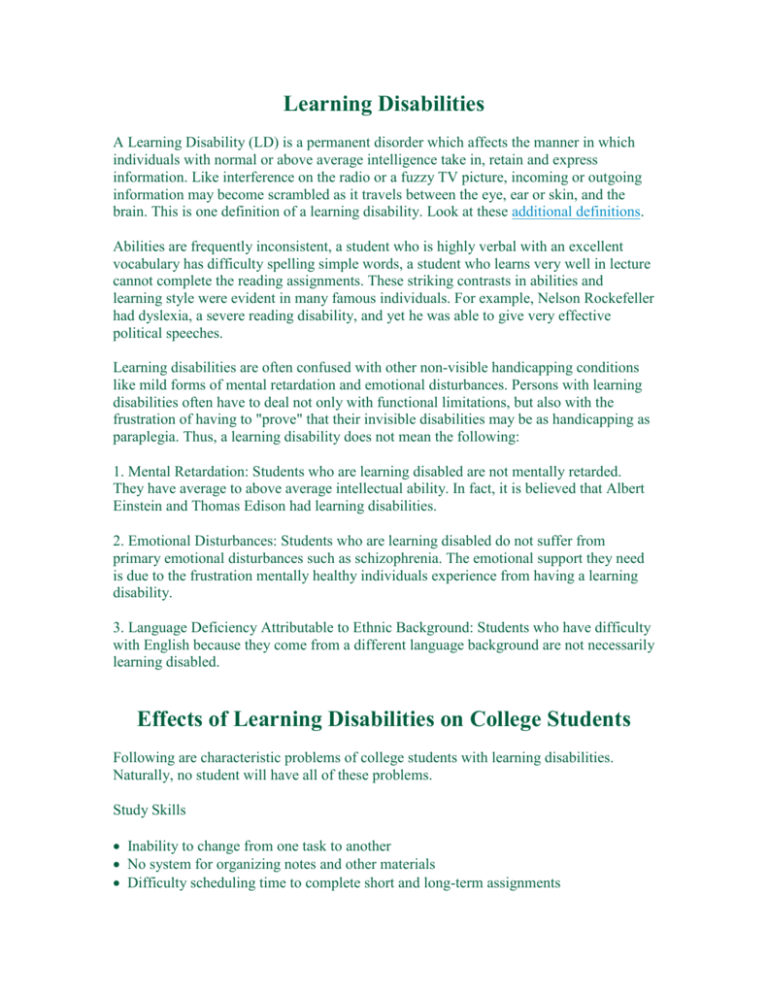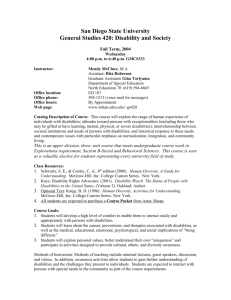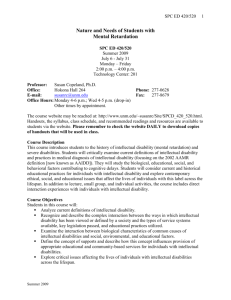Learning Disabilities
advertisement

Learning Disabilities A Learning Disability (LD) is a permanent disorder which affects the manner in which individuals with normal or above average intelligence take in, retain and express information. Like interference on the radio or a fuzzy TV picture, incoming or outgoing information may become scrambled as it travels between the eye, ear or skin, and the brain. This is one definition of a learning disability. Look at these additional definitions. Abilities are frequently inconsistent, a student who is highly verbal with an excellent vocabulary has difficulty spelling simple words, a student who learns very well in lecture cannot complete the reading assignments. These striking contrasts in abilities and learning style were evident in many famous individuals. For example, Nelson Rockefeller had dyslexia, a severe reading disability, and yet he was able to give very effective political speeches. Learning disabilities are often confused with other non-visible handicapping conditions like mild forms of mental retardation and emotional disturbances. Persons with learning disabilities often have to deal not only with functional limitations, but also with the frustration of having to "prove" that their invisible disabilities may be as handicapping as paraplegia. Thus, a learning disability does not mean the following: 1. Mental Retardation: Students who are learning disabled are not mentally retarded. They have average to above average intellectual ability. In fact, it is believed that Albert Einstein and Thomas Edison had learning disabilities. 2. Emotional Disturbances: Students who are learning disabled do not suffer from primary emotional disturbances such as schizophrenia. The emotional support they need is due to the frustration mentally healthy individuals experience from having a learning disability. 3. Language Deficiency Attributable to Ethnic Background: Students who have difficulty with English because they come from a different language background are not necessarily learning disabled. Effects of Learning Disabilities on College Students Following are characteristic problems of college students with learning disabilities. Naturally, no student will have all of these problems. Study Skills Inability to change from one task to another No system for organizing notes and other materials Difficulty scheduling time to complete short and long-term assignments Difficulty completing tests and in-class assignments without additional time Difficulty following directions, particularly written directions Interpersonal Skills Impulsivity Difficulty delaying resolution to a problem Disorientation in time -- misses class and appointments Poor self-esteem Reading Difficulty reading new words, particularly when sound/symbol relationships are inconsistent Slow reading rate -- takes longer to read a test and other in-class assignments Poor comprehension and retention of material read Difficulty interpreting charts, graphs, scientific symbols Difficulty with complex syntax on objective tests Writing Problems in organization and sequencing of ideas Poor sentence structure Incorrect grammar Frequent and inconsistent spelling errors Difficulty taking notes Poor letter formation, capitalization, spacing, and punctutation Inadequate strategies for monitoring written work Oral Language Difficulty concentrating in lectures, especially two to three hour lectures Poor vocabulary, difficulty with word retrieval Problems with grammar Math Difficulty with basic math operations Difficulty with aligning problems, number reversals, confusion of symbols Poor strategies for monitoring errors Difficulty with reasoning Difficulty reading and comprehending word problems Difficulty with concepts of time and money Developing a Tutoring Program Before determining what to work on, both you and the student must understand the student's specific strengths and areas for improvement. Your first few sessions together should be spent discussing the student's learning disability, how it may affect him/her in school, and techniques for compensating for it. This is also the time to build trust. We believe this can be accomplished by: 1. Treating the student as an equal. The student may have a learning disability, but he/she also possesses knowledge and talent that you don't have. 2. Listening to what is important to the student. what areas of learning does he/she want to focus on? 3. Creating an atmosphere that permits the student to confide in you. It is important to find a location away from peers and teachers, where learning disabled students can feel comfortable to tackle problems without fear of being embarrassed. Final determination of what to work on is based on the following factors: 1. The nature and severity of the student's learning disability. 2. The student's concerns. 3. Course requirements. We suggest listing information under each factor. Then use this information to determine priorities for the tutoring program. Some students may just require assistance with papers and reading assigned in their courses. Others also may want to work on supplementary materials. For example, a student planning to take a statistics course may want to review basic algebra concepts and overcome problems understanding fractions. A student with reading comprehension difficulties may want to focus on ways to improve his/her vocabulary. There is a wealth of information regarding learning disabilities on the Internet. Check out this one site for links to additional information, different web sites, chat rooms, and resources.









